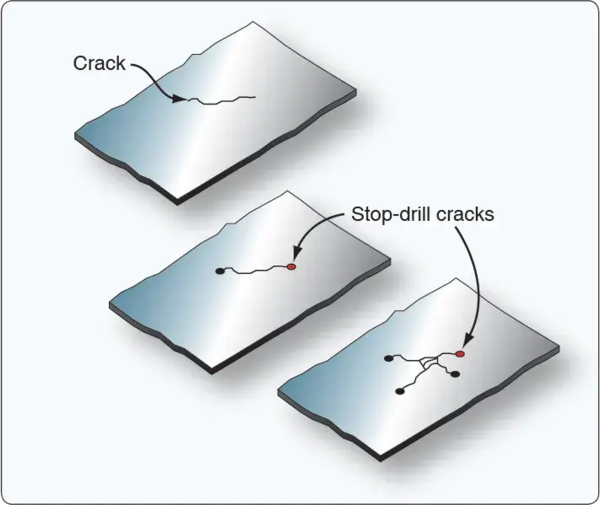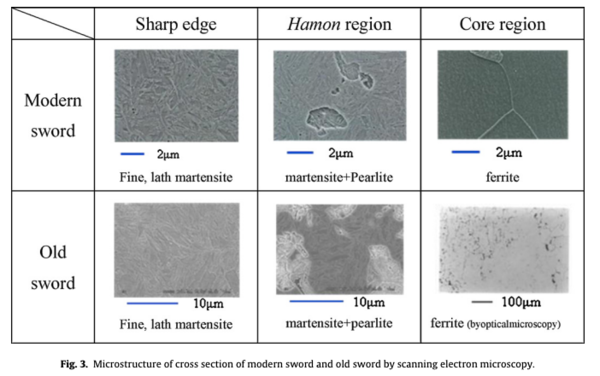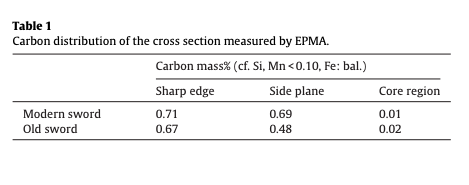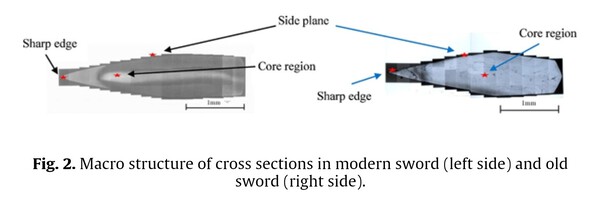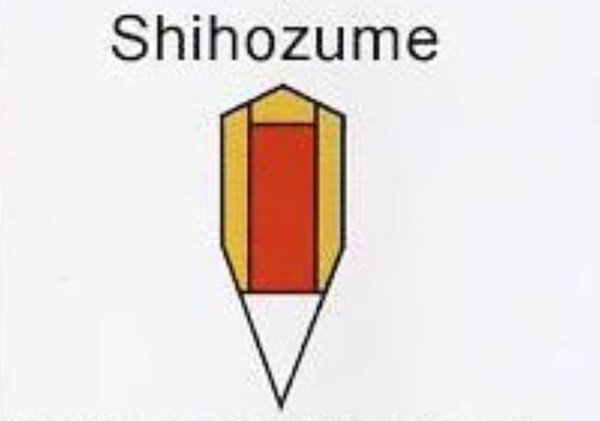-
Posts
931 -
Joined
-
Last visited
-
Days Won
6
Content Type
Profiles
Forums
Events
Store
Downloads
Gallery
Everything posted by mas4t0
-
It kind of looks like it's been "repaired". Crack propagation is caused by the immense stress concentration at the crack tip. This causes the crack to propagate through the material as shown below. The way to "repair" a crack without patching it or inserting material is known as stop-drilling. The end of the crack is drilled to reduce the stress concentration and prevent further propagation. The kirikomi doesn't look natural to me. While it obviously hasn't been drilled, it looks like someone has eased the end of it. This is the correct thing to do from a fracture mechanics perspective, but I'm not sure if I'm seeing things correctly. Does anyone know of this being done on blades where it's worthwhile? I've never heard of or seen it before on nihonto so I'm quite curious.
-

HELP! DOES ANYONE KNOW PETER (in UK)
mas4t0 replied to Matsunoki's topic in General Nihonto Related Discussion
That was a nice thread to read though. 👍 -
What you're seeking is termed Non-Destructive Testing (NDT). X-rays and ultrasound scans will tell you more about the blade, as they can show delaminations and voids below the surface. A good quality portable ultrasound scanner can be had for a few thousand dollars.
-
I've heard mention a few times of these special Jacques PMs, I had a disagreement with Jacques a while ago, but never earned the PM unlock. 🙄 Would anyone like to share theirs with me so I can see what I'm missing?
-

Question about katana length to height.
mas4t0 replied to Barrett Hiebert's topic in General Nihonto Related Discussion
Barrett, I'm sure I provided you with a link to a translation of an article written by Nakamura Taisaburo (which covers this topic in depth) in one of your earlier threads. If you look there you'll find all the info you need (including other important features to keep in mind, such as suitable cross sectional geometry, balance point, nakago length and sori). If you're buying a traditionally made shinken, I'd stay within the upper length limits mentioned there, if you're looking at a non-traditional blade the extra strength of the steel will allow for whatever length is best suited to you and the other dimensions can be scaled accordingly (though a blade within the limits mentioned might be long enough for your needs). As Michael mentioned, this is elaborated further in The Spirit of the Sword, as I recall you were looking to source a copy in Canada? A thread in the want to buy area of the forum should find you a copy quickly and easily. It isn't a rare or expensive book. -
Correct. It cuts down on the amount of (expensive) steel required; kogatana don't have the strength requirements of swords, so steel is only required for the sake of edge holding. As the iron is unhardenable you cannot get a hamon on that side, but it's easy to file and engrave.
-

Why Kamakura = best swords ever??
mas4t0 replied to Nicolas Maestre's topic in General Nihonto Related Discussion
Pangloss, I'm familiar with the content in each of those pages. You'll notice that the page on atomic diffusion has the following to say with regards to diffusion in polycrystalline materials (i.e. solids that consist of many small crystals [“grains”]) such as the material we've been discussing. *I used your own words next for clarity. and on the other you say that (picture below) Wouldn't it be like a contradiction. (sic) -

Why Kamakura = best swords ever??
mas4t0 replied to Nicolas Maestre's topic in General Nihonto Related Discussion
Ok Pangloss, lets review. First off, regarding the Dunning/Kruger effect, that's precisely what I expected you to say. Second, if you consider Avogadro's constant to be relevant whenever you have solid, liquid or gas (though for some reason not plasma) am I to understand that you write your recipes in terms of the number of particles rather than in terms of the mass of the ingredients? If so, I'm impressed (but also perplexed) by your eccentricity. Finally, with regards to the thread you linked (which you've now seemingly removed from your post, but which is fortuitously preserved in my quote in this post) this is a quote from Kevin R. Cashen (a highly respected ABS Master Smith and the only name on that thread I recognise). What's the problem? This is the same thing as Jean and I have been explaining (i.e. carbon diffusion). -

Why Kamakura = best swords ever??
mas4t0 replied to Nicolas Maestre's topic in General Nihonto Related Discussion
I apologise Simon and (almost) everyone else. -

Why Kamakura = best swords ever??
mas4t0 replied to Nicolas Maestre's topic in General Nihonto Related Discussion
Pangloss, In short, no it isn't. Why would you think that? What do you think the relevance of NA (the number of constituent particles per mole) is to this discussion? The number of molecules or atoms in a body would only be given by Avogadro's constant if the mass is equal to the molar mass - otherwise you have to multiply the number of moles by Avogadro's constant to get the number of particles. The amount of matter is given by the mass, NA is simply a constant to allow conversion from the quantity of mass to the number of particles (assuming you know the chemical composition). Conservation of mass does not imply conservation of mass within a given layer or indeed within the billet as a whole, just that no matter is created or destroyed. As you well know; the overall mass of the billet is reduced during processing (though the mass is obviously conserved overall as there has been no nuclear fusion, nuclear fission, annihilation, etc). The mass lost from the billet or from a given layer obviously still exists (somewhere) so mass is conserved. Or were you going to tell us that gain weight (through overeating) and weight loss (through diet and exercise) are impossible, as the human body is an independent body and mass can neither be gained or lost? Of course mass and energy are zero sum (as they equivalate and are conserved), but the allocation can change. I have a reasonable grasp on physics and chemistry, but I'm starting to seriously doubt that you do. If your understanding of physics is misaligned with empirical findings to such an extent that you conclude (rigorously) observed phenomena to be impossible, perhaps it's time to reassess your grasp of physics? As you contiunally refer to yourself as a physicist, that would imply you have a pHd in the field. How did you procure a pHd in physics without a basic grasp of the scientific method? I'm referencing material from the relevant scientific discipline - maybe you should take up your misgivings with the field of metallurgy as a whole (as my physicist acquaintance mentioned earlier did with the field of economics)? Why did you remove the Dunning-Kruger effect from your signature if you're so determined to be a poster boy for it? -

Why Kamakura = best swords ever??
mas4t0 replied to Nicolas Maestre's topic in General Nihonto Related Discussion
Hi Alex, Jean did some simple calculations earlier in the thread. I think the key point is that this is happening at each layer where there's a diffusion gradient. If the layers are 0.06mm thick (for example) and there's a diffusion gradient on both sides, it only has to diffuse across 0.03mm (0.06/2), which by the above numbers would take ~15 minutes. Clearly the billet spends a lot longer than 15 minutes at forge welding temperature, so we would expect full homogenisation of carbon as a result of the refining process. It's not particularly relevant when considering lamination (i.e. san-mai) as there are orders of magnitude fewer layers, and they are orders of magnitude thicker. But even in that case smiths will generally forge weld a short, stout laminated billet (to maximize layer thickness and minimise diffusion) and then draw that out to form the blade. -

Why Kamakura = best swords ever??
mas4t0 replied to Nicolas Maestre's topic in General Nihonto Related Discussion
As promised, I'm going to try and avoid any opinions or analysis of my own (they'd surely be incorrect), but this carbon diffusion denial is quite ridiculous. It's been well known and well studied for decades. It's well known because it's the root cause of many problems in industrial applications. I understand your doubts Alex and your reasoning, but this is a diffusion process which takes place in addition to the mixing effect you described - to observe diffusion in your inks you'd probably need to dilute them significantly with a solvent. This isn't an unfounded belief, it's based on a huge body of empirical evidence. I'm not going to type up entire chapters from text books on the topic, but I would encourage people to read some relevant books. Anyhow: From Elements of Metallurgy and Engineering Alloys (link): Chapter 5: Diffusion: Abstract: Diffusion is the movement of atoms through the crystalline lattice. This chapter discusses the two main types of diffusion that can occur in solids: interstitial diffusion and substitutional diffusion. It describes Fick's first and second laws of diffusion, with emphasis on several applications of the latter. The chapter also provides information on the temperature dependence of diffusion, intrinsic diffusion coefficients (Kirkendall effect), and high diffusion paths. From Steel Metallurgy for the Non-Metallurgist (link): Chapter 7: Diffusion—A Mechanism for Atom Migration within a Metal: Abstract: Diffusion is the primary mechanism by which carbon atoms move or migrate in iron. It is driven by concentration gradients and aided by heat. This chapter provides a practical understanding of the diffusion process and its role in the production and treatment of steel. It discusses the factors that determine diffusion rates and distances, including time, temperature, and the relative size of the atoms involved. It also describes two heat treating methods, carburizing and decarburizing, where carbon diffusion plays a central role. Are we happy now? -

Why Kamakura = best swords ever??
mas4t0 replied to Nicolas Maestre's topic in General Nihonto Related Discussion
(Professor) Jacques, Thank you for so generously sharing your great wealth of knowledge. If I can't read a simple paper, I clearly have nothing of value to say here, so I'll bow out and avoid further comment. I know that the word "Shihozume" is not mentioned in the study, but a similar type of lamination is shown and described. I used the word and provided an illustration for added clarity as it is a term that all here will be familiar with. Why in your (expert) opinion do those regions have differing carbon content, and why is lamination visible in the cross section if the blade is not in fact laminated? This thread has reminded me of an old acquaintance (a physicist) who wrote a simulation and a paper modelling the economy on ideal gas laws. It was a masterpiece, complete with references to papers which had no relevance to what he was using the reference to support and to (unpublished) papers he had written (which obviously only referenced other papers he had written and which had not been accepted for publication, a closed system as it were); always a lovely flourish, showing true mastery of the scientific process. His conclusions were predictably absurd. In effect he concluded that if someone wealthy were to interact with someone less well off, the wealthier party should give the other party half of their net worth - in so doing, it would naturally follow that all societal problems and political differences would resolve themselves in a matter of days (remember that this was a serious piece of academic work and was not intended as satire). He also considered (entirely arbitrarily) that this should only apply when the wealth of the wealthier party was above a certain threshold, which he was of course below. He was angry and upset that no major economics journal was interested in publishing his groundbreaking magnum opus. His more recent extra-curricular activities have involved carrying out a study on bus punctuality, which had major methodological flaws (which is quite impressive for such a simple project). I don't grasp your meaning of "bad-faith", so I suppose I'll go re-read some work by Sartre (maybe when I'm done and have thoroughly misunderstood his meaning you'll be so kind as to help me with that too). The below is from a class on Mathematics for Computer Science. It's been quite a few years since I took the class, but I like to keep a copy on hand. I think we're approaching a full-house (a rare accomplishment for a single thread), if we keep this going I'm confident we can get there! Popular Proof Techniques NOT Allowed -

Why Kamakura = best swords ever??
mas4t0 replied to Nicolas Maestre's topic in General Nihonto Related Discussion
Thank you Jacques. I'm somewhat confused by what you're saying, could you please elaborate? It seems quite clear that they're referring to three distinct regions, with different carbon content (and different microstructures), but which are each being treated as internally homogeneous. You can see below that: the "sharp edge" has the highest carbon content on each sword and a fine, lath martensite microstructure the "side plane" has lower carbon content on each sword and a martensite + pearlite microstructure the "core region" has very low carbon content on each sword and a ferrite microstructure. This is what would be expected for a differentially hardened laminated blade which was constructed in a Shihozume type way. What's your explanation of this? It very much seems like they are treating these regions as each being internally homogeneous but clearly distinct from each other as in a laminated blade (with no mention of hada, blending or pattern-welding). How do you reach the conclusion that they're referring to different layers in the hada? -

Why Kamakura = best swords ever??
mas4t0 replied to Nicolas Maestre's topic in General Nihonto Related Discussion
Thank you for that information Jussi, I'm always amazed by your level of commitment and grateful for your contributions. Whenever I try something like this (which is rare) I lose count or forget what I was doing. Invariably I end up writing some Python code to automate the process. -

Why Kamakura = best swords ever??
mas4t0 replied to Nicolas Maestre's topic in General Nihonto Related Discussion
This section? I also forge Damascus steel from different steels, which are combined with each other in such a way that the finished blade has a clearly visible structure after etching. "Damascus" is a commonly used term to refer to pattern-welded steel. It is true that the pattern of "damascus" is revealed through etching (I believe Jean gave a brief overview of the relevant Chemistry earlier in this thread). But Japanese swords are not "damascus" and the hada is revealed by polishing on stones (as you described earlier). In the image above they've delineated the three regions and you can visually observe the lamination layers. 1) The "sharp edge" 2) the "side plane" and 3) the "core region". This would seem to correspond to: These swords are found to be composed of two kinds of middle carbon steel, outside [i.e. "sharp edge" and "side plane"] and low carbon steel, inside [i.e. "core region"]. In other words, Japanese sword is one of composite materials. *[ ] added by me It seems like a very liberal and creative reading of the text to consider the above quote as referring to layers in the hada (which isn't pictured) as opposed to the macro structure (which are shown and annotated). If there were discussing hada being formed from two different kinds of middle carbon steel I would have expected some more information on how they established this fact. I'm not sure precisely what's meant by "different kinds of middle carbon steel". I had presumed that it referred to different levels of carbon content (which would indicate lamination). For the reasons explained by Jean earlier, unless the layers were relatively thick (and the pattern-welding took place after refinement of the steel), you wouldn't maintain a meaningful difference in carbon content between layers in the hada. Of course I could well be mistaken. My degree only included a couple of courses on metallurgy and I only have a handful of textbooks on the topic - which is to say that while I have a basic grasp of smelting, heat treat, alloying, etc and familiarity with relevant terms and concepts (eutectoids, carbides, unit cells, microstructures, grain, etc) I obviously know very little compared to a specialist (be that a smith or a metallurgist). -

Why Kamakura = best swords ever??
mas4t0 replied to Nicolas Maestre's topic in General Nihonto Related Discussion
Is this English translation correct? There's no contradiction there with relation to the thread. Pattern welding and lamination are two different things. You could do both in a single blade, but you can also make a blade of pattern welded steel with no lamination or a laminated blade with no pattern welding or hada (as in a san-mai blade with stainless steel cladding and a carbon steel core). I'll add some photos: "Coreless-damascus" blade showing pattern welded steel (dissimilar alloys) with no lamination: Stainless san-mai laminated blade, with no pattern welding or hada, but with a core of carbon steel (for the cutting edge) sandwiched between a layer of stainless steel on each side: Stainless "damascus" (i.e. pattern welded) cladding on a san-mai laminated blade with a tool-steel (CPM-M4) core: -

Why Kamakura = best swords ever??
mas4t0 replied to Nicolas Maestre's topic in General Nihonto Related Discussion
Along that same line (if we're being skeptical) a photo of two people seemingly engaged in conversation is not proof of what was said or proof that a conversion actually took place. What in those studies do you think contradicts what Jean wrote? The conclusion from Characteristics of Japanese sword produced from tatara steel: The short sword prepared from tamahagane by traditional technique was observed by optical microscopy and SEM/EBSD measurements. The sizes of lath martensite were identified with average block thickness 0.47 um and packet size 3.6 um, respectively, which were smaller than those of Fe–C steel. The morphology of packet and prior austenite grain boundaries were quantified, and it was found that the boundaries in the short sword has small curvature and small ratio of straight line compared with ordinary Fe–C steel. It was understood by this analysis that grain boundary of the short sword is short wavelength wavy patterns. The conclusion from Study of Japanese sword from a viewpoint of steel strength: Four-point bending test has been performed to estimate the strength of Japanese sword for the first time in addition to a series of metallurgical investigations. The observed main features are as follows: The microstructure of sharp edge in Japanese sword is fine lath martensite, resulting high hardness. The sharp edge has extremely large compressive stress like carbonized steels. This stress should contribute to steel strength of sharp edge greatly. The strength of 4645 MPa for sharp edge in modern sword was measured, and the fracture surface after bending test showed that the crack propagation behavior and the change in the macroscopic direction of propagation were observed. I read both papers thoroughly, but must have somehow missed the parts relevant to this discussion. Would you be so kind as to quote them or direct me to them? Are you perhaps referring to this passage? These swords are found to be composed of two kinds of middle carbon steel, outside and low carbon steel, inside. In other words, Japanese sword is one of composite materials. There are hardly harmful impurities such as Si and Mn which decrease the sword quality. This is referring to lamination (as shown below) as opposed to blending them together to form hada. I don't see any discussion regarding two dissimilar steels being blended to form hada. Having read both papers I'm quite confused as to what you and Alex see as evidence relevant for this discussion. I must have missed it and would very much appreciate clarification. -

Why Kamakura = best swords ever??
mas4t0 replied to Nicolas Maestre's topic in General Nihonto Related Discussion
Does anyone have easy access to a high-resolution electron microscope? If so, they'd be able to see what's going on. From Physics and Engineering of New Materials pp 305–310 (link to book); this is regarding wootz specifically, but the same method of inspection should work with Nihonto: Using high-resolution electron microscopy, we have found in a sample of Damascus sabres from the 17th century both cementite nanowires and carbon nanotubes. These might be the missing link between the banding and ancient recipes to make that ultrahigh carbon steel. The sample considered belonged to the wootz-type of Damascus steel which is fundamentally different from welded Damast. The nanotubes have only been revealed after dissolution of the sample in hydrochloric acid. Some remnants showed not yet completely dissolved cementite nanowires, suggesting that these wires were encapsulated by carbon nanotubes. Only recently, considerable progress has been achieved in reproducing the process of making the characteristic pattern of wootz. We propose a connection between impurity segregation, nanotube formation, nanotube filling with cementite, cementite wire growth, and formation of large cementite particles. Needless to say that the presence of a nanostructure will have an impact upon the mechanical properties. I'm not suggesting that Nihonto are made from a steel similar to wootz, or that the findings would be similar - just that the methodology (using an electron microscope) should establish clearly what it is that we're seeing. -

Why Kamakura = best swords ever??
mas4t0 replied to Nicolas Maestre's topic in General Nihonto Related Discussion
This video might help people to visualise grain size and some other aspects of heat treat (it's very beginner friendly): -

Why Kamakura = best swords ever??
mas4t0 replied to Nicolas Maestre's topic in General Nihonto Related Discussion
Of course the metal is folded as part of the refining process, but due to that process the carbon content has been homogenised throughout a piece of material. These are then laminated together to form the final billet. Hada does not require dissimilar alloys. The cladding on this knife is folded (impure) iron, which began as a single piece of iron before being folded on itself and used to clad the high carbon core steel; the pattern is revealed by polishing on natural stones. -

Why Kamakura = best swords ever??
mas4t0 replied to Nicolas Maestre's topic in General Nihonto Related Discussion
1, unless the blade is laminated in a way which leaves both Kawagane and Hagane exposed, such as Honsanmai. But in that case you're seeing two distinct materials side by side (as with a san-mai blade) rather than blended and pattern welded together (as you might see on a traditional Chinese sword). -

Why Kamakura = best swords ever??
mas4t0 replied to Nicolas Maestre's topic in General Nihonto Related Discussion
The material first needs to be refined. The section quoted is discussing lamination of material after it's been refined by folding. The discussion is currently focused on the hada left by folding the material in order to refine it. I doubt both of those reasons, due to 1) carbon migration (as described by Jean) and 2) the slag inclusions are removed through the refining process (i.e. folding), which also homogenises the material. The material for the respective layers (of lamination) is kept separate until the final billet is assembled and drawn out. -

Why Kamakura = best swords ever??
mas4t0 replied to Nicolas Maestre's topic in General Nihonto Related Discussion
Thank you Jean for clarifying and elaborating. I had guessed that the small amounts of Molybdenum and Vanadium would be drawn to the surface and thereby concentrated at the welds - with high enough concentration to form carbides along the weld lines. As that isn't the case, what would you guess we're actually seeing? Clearly we're seeing the welds, but I'd very much appreciate your insight as to what's going on metallurgically to create the visible contrast. -

Why Kamakura = best swords ever??
mas4t0 replied to Nicolas Maestre's topic in General Nihonto Related Discussion
I have a sword from Walter Sorrels (the Bladesmith who's videos were linked above). The blade has been traditionally polished, but the visible appearance of the hada is (very) noticeably different to what you'd see on Nihonto or what you'd see on a folded iron-clad Japanese knife. You can see that it's composed of dissimilar layers. The hada that we're used to on Nihonto looks a lot more like alloy banding than layers of different materials. Here's a photo of a monosteel blade (Togashi Blue #2) showing alloy banding where no folding or pattern welding has taken place. There's a few factors which determine alloy banding and the smith can quite well control it (even without folding the metal). As I understand it, alloy banding can occur whenever there's presence of carbide forming alloying elements (Cr, V, W, Mo, etc), which brings me back to the idea of a material composition (i.e. chemical) difference as the underlying cause of the different appearance of hada in different eras (beyond the control of the smith) discussed earlier. I assume that the hada is visible due to differences in hardness, which is brought out when the blade is polished. I don't believe though that those hardness differences are (in the case of Nihonto) due to dissimilar materials, but rather I would guess they're due to differences in carbide formation (as seen in alloy banding) within the folded steel. This thread (regarding alloy banding) over at bladesmiths-forum might be of interest to some: https://www.bladesmithsforum.com/index.php?/topic/2703-understanding-alloy-banding/




